10:00 AM | 2014 - another down year in the US for tornadoes, hurricanes, extreme heat, wildfires and drought
Paul Dorian
Discussion
Overview Whether you’re talking about tornadoes, hurricanes, extreme heat, wildfires or drought, there is good news this year in that similar to last year, these extreme weather-related events are down in the U.S. compared to normal and, in the case of land falling major hurricanes, to historically quiet levels.
Tornadoes To begin with, the number of tornadoes in the US this year is on pace to be one of the lowest totals in the last ten years and well below the 9-year average (2005-2013) of 1478. The table below lists the number of tornadoes in the US for this year (preliminary count through 11/03) and full-year totals going back to 2005 [Data source: NOAA, http://www.spc.noaa.gov/climo/online/monthly/newm.html; http://www.spc.noaa.gov/wcm/]
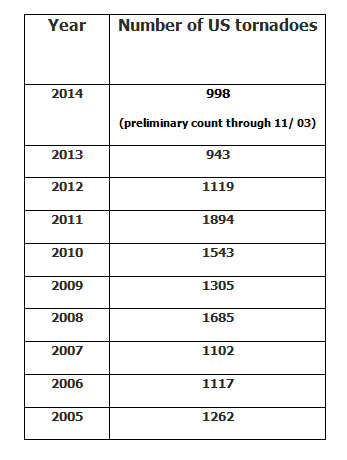
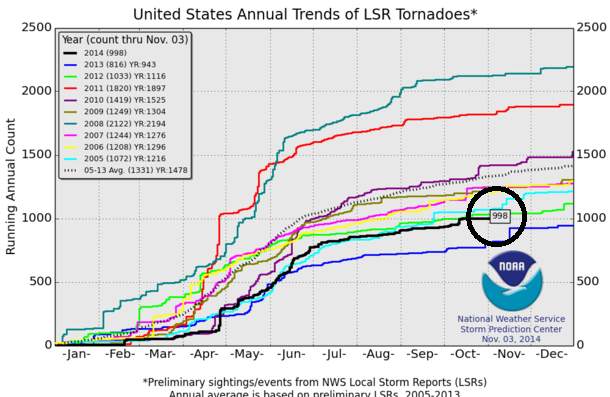
Hurricanes As far as hurricanes are concerned and keeping in mind that the Atlantic Basin tropical season isn't quite over yet, the 2014 hurricane season has generally been a quiet one for the continental U.S. and below normal for the Atlantic Basin as a whole. As of November 3rd, there have been eight named storms this year in the Atlantic Basin - Arthur, Bertha, Cristobal, Dolly, Edouard, Fay, Gonzalo and Hanna. Six of these storms became hurricanes and two reached major hurricane status (category 3 or higher), but only Arthur impacted the continental US (Outer Banks of North Carolina). In terms of Accumulated Cyclone Energy, or ACE, this tropical season in the Atlantic Basin is only 67% of normal when using the 1981-2010 time period for comparison (Data source: Dr. Ryan Maue at Weather Bell Analytics; http://models.weatherbell.com/tropical.php). ACE is a commonly-used metric for activity because it is not dependent on exact numbers of named storms or hurricanes, but rather is based on both the intensity and longevity of all tropical storms and hurricanes (so a long-lived tropical storm could contribute as much ACE as a short-lived storm that reached hurricane intensity).
An interesting stat with respect to US hurricanes has to do with the fact that we are currently in the longest period since records began without a major hurricane strike in the US (i.e., category 3, 4 or 5). The last major hurricane to strike the US was Hurricane Wilma during late October of the record-breaking year of 2005 - let’s hope this historic stretch continues. October 24th marked the 9th anniversary of the last major hurricane hit in the US, the last one being Wilma in the southwestern part of Florida. Florida has, in fact, quite amazingly now gone through their longest stretch ever without a hurricane of any kind – nine years as of October 24th – with the next longest streak in records dating back to 1851 being just five seasons from 1980-1984. In 2004 and 2005 alone, seven hurricanes hit Florida (Charley, Frances, Jeanne, and Ivan in 2004; Dennis, Katrina, and Wilma in 2005).
By the way, just as another point of comparison, in 1954 the US was hit by 3 major hurricanes in less than 10 weeks.
 [Running 9 year mean in Florida]
[Running 9 year mean in Florida]
Extreme Heat In addition to tornadoes and hurricanes, extreme heat is also down across the US this year when looking at frequency of 90 degrees days at all of the US Historical Climate Network (HCN) stations going back to the late 1800’s and this continues a long-term downward trend since the 1930’s. In fact, the percentage of US HCN stations to reach 90 degrees so far this year (through 10/24) has been the smallest on record. The most widespread heat occurred in 1931, when more than 98% of stations reached 90 degrees.
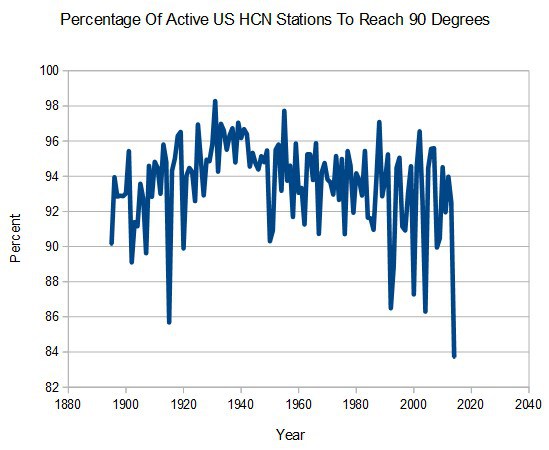
(Data source: NOAA, USHCN reporting stations; Steve Goddard, http://stevengoddard.wordpress.com/2014/10/25/us-having-its-coolest-year-on-record/ )
This year also continues a downward trend in the frequency of 100 degree days since the 1930’s as seen in the chart below. The five summers with the highest number of 100 degree days across the US are as follows: 1936, 1934, 1954, 1980 and 1930.
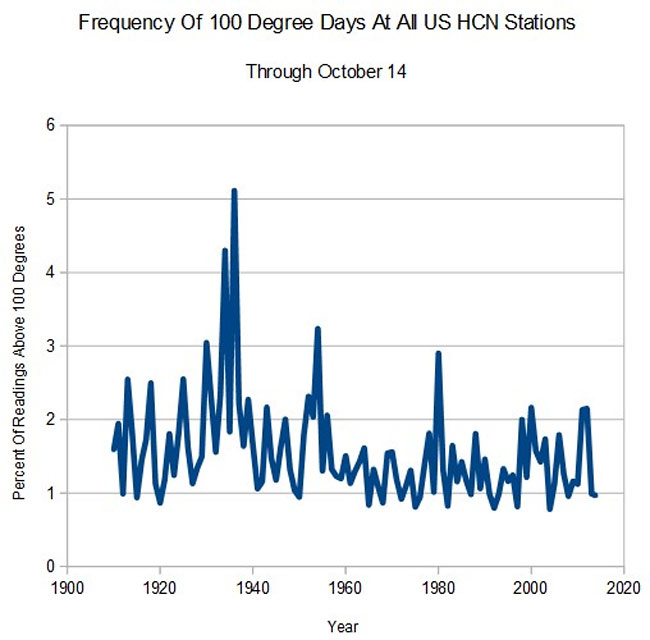 (Data source: NOAA, US HCN reporting stations; Steve Goddard)
(Data source: NOAA, US HCN reporting stations; Steve Goddard)
Wildfires As far as wildfires are concerned, the amount of acres burned across the US was the lowest in the last eleven years through October 10th and the number of wildfires was the second lowest in that same time period – both well below the 2004-2013 average (table below).
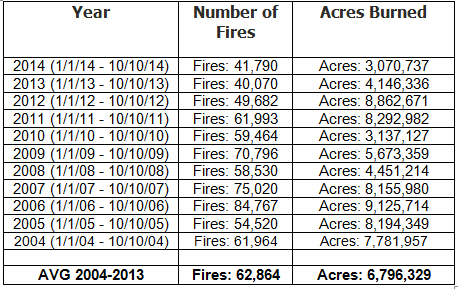 (Data source: National Interagency Fire Center; http://www.nifc.gov/fireInfo/nfn.htm, http://www.nifc.gov/)
(Data source: National Interagency Fire Center; http://www.nifc.gov/fireInfo/nfn.htm, http://www.nifc.gov/)
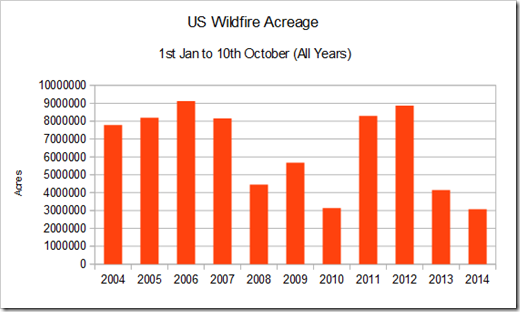
Drought Finally, despite the fact that much of California is suffering through severe drought, 63% of the country had no drought conditions as of October 28th and this is even higher than one year ago at this same time when about 48% of the country had no drought conditions (data source: http://droughtmonitor.unl.edu/Home/TabularStatistics.aspx; Roger Pielke, Jr). This actually continues a longer-term trend which shows a rather benign look to the Palmer Drought Severity Index in the last several years across the contiguous US (values generally between +1 and -1 since around 2001). The most severe drought conditions in the contiguous US occurred during the middle 1930's and then again in the middle 1950's when the Palmer Drought Severity Index dropped below -3.
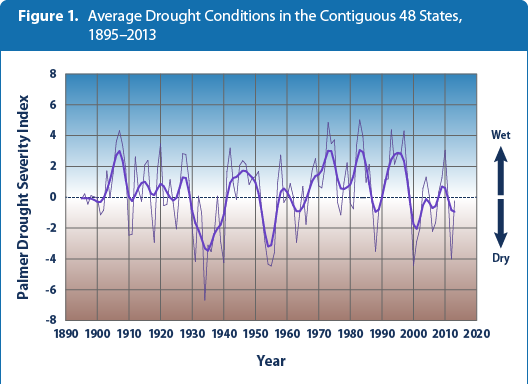
Paul Dorian/Meteorologist VencoreWeather.com on Facebook, Twitter and liveweatherblogs.com paul.b.dorian@vencore.com